(1986,US)

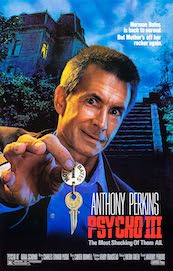

[review by JA Kerswell]
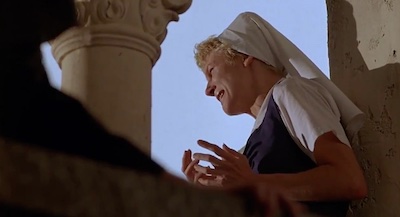 |
|
| "What is it you can't face?". Maureen (Diana Scarwid) has a crisis of faith in PSYCHO III. |
PSYCHO III is good to its name, as it both paradoxically resists and embraces then popular subgenre movie tropes. This third time around sees Anthony Perkins take the director’s reigns and step back into his most famous role; as he invites the audience to sympathise and fear a newly off-kilter Norman Bates. Comedy, that is blacker than the eyeholes of his mother’s desiccated corpse, and slasher movie mayhem collide in a sequel that perhaps offers little new - but is still an entertainingly gonzo slice of mid-80s mayhem.
Set less than a month after the events of Richard Franklin’s PSYCHO II (1983), the film opens with a nod to Hitchcock’s VERTIGO (1958). A nun, Maureen (Diana Scarwid) threatens to throw herself from a bell tower after losing her faith in God. An attempt to save her goes horribly wrong when one of the other nuns falls to her death. Maureen leaves the convent with her suitcase (presumably after being asked “What is you can’t face?”) - and hitches a ride with sleazy drifter Duane (Jeff Fahey). They part ways after Duane forcibly puts the moves on her and Maureen is left to traipse the highway alone. Yet all roads lead to the Bates Motel and they both eventually find themselves checking in.
The police, led by Sherrif Hunt (Hugh Gillin), are still looking into the disappearance of local waitress Mrs Spool (Claudia Bryar). In Part II, it was revealed that she had been behind the killings and told Norman that she was his real mother. With his newly restored sanity eroded, he had killed her in his kitchen with a spade to the head. Her taxidermied body now takes place in the prized rocking chair and directs Norman to kill once again.
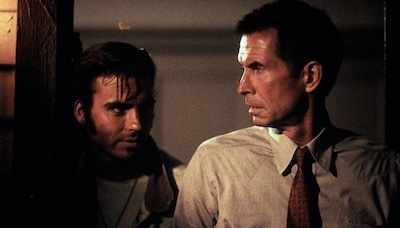 |
|
| PSYCHO III brings back Anthony Perkins both as Norman Bates and in a directorial capacity - here with sweaty chancer Duane (Jeff Fahey). |
Not knowing of his fragile state of mind, most of the townspeople believe Norman has suffered enough. But another returning character, journalist Myrna (Lee Garlington) isn’t so sure - and presses a reluctant Norman for details of his supposed recovery.
Meanwhile, he has installed Duane as the office manager of the Bates Motel. Norman is also intrigued by Maureen’s similarities in looks - and sharing the same initials - as PSYCHO’s (1960) first victim Marion Crane (Janet Leigh). Giving her the same room at the motel tips him over the edge and - directed by mother - dons her clothes and enters the bathroom to kill Maureen. Only to find, in a neat inversion of expectations, that she has slit her wrists in an attempt to take her own life. Fears are seemingly allayed about Norman’s fragile sanity after he is praised for saving her. However, mother is still talking and there are murderous deeds to be done …
The furore around plans to make PSYCHO II was akin to someone suggesting a modern sequel to the likes of CITIZEN KANE (1941) or CASABLANCA (1942). Although eventually critics begrudgingly gave praise for Franklin’s cleverly constructed sequel. It had been enough to get Anthony Perkins on board after years of refusing to revisit his most famous role. The film seemed to purposefully acknowledge the ongoing impact of Hitchcock’s as the ‘Grandaddy of the slasher movie’ - especially in a scene where two teenagers are killed in the basement of the Bates’ Gothic mansion. The sequel had previously been mooted with Janet Leigh’s daughter Jamie Lee Curtis dying in a hot tub - in a very early 80s update of the famous shower scene.
 |
|
| Murders start again at the Bates Motel in the second sequel to Alfred Hitchcock's PSYCHO (1960). |
In Part III, Perkins is also under the shadow of twin Goliaths - Hitchcock’s original PSYCHO and the crimson tidal wave of slasher movies that had followed HALLOWEEN (1978) and FRIDAY THE 13TH (1980). Wisely, he realises he can’t escape the comparisons to both and decides to make PSYCHO III a black comedy in the finest Grand Guignol tradition. In one scene someone says “I did leave the bathroom in a mess”. Norman replies “I’ve seen worse”. In another, a character unwittingly sucks on bloodied ice cubes that are hiding a dead body.
There is no mystery here as to who is doing the killing. Rather the suspense is generated by whether Norman can wrestle control from his mother and be saved by his burgeoning love for Maureen. The killings of nubile young women around the Bates Motel are almost an afterthought.
Performances are excellent from the cast. Perkins recaptures that mixture of innocence and malevolence perfectly. He said on a press tour for the movie: “I wasn’t trying to make him scary - but scared. What I like about the whole approach of ‘Psycho III’ is that it provides us with a unique opportunity to go backstage with Norman Bates. We know sometimes he does his mother’s bidding, but lots of the time, he doesn’t. He obeys her, but he hates her. … I have a lot of affection for Norman, and a lot of sympathy. So does the audience, I think. He’s not just a monster. He’s tortured. The real secret of the ‘Psycho’ movies is that they are tragedies first and horror movies second.”
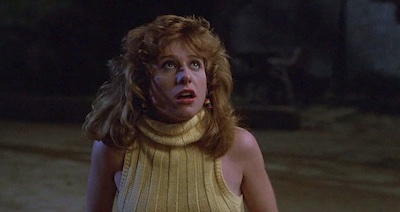 |
|
| PSYCHO III features a couple of slasher movie deaths that wouldn't be out place in a FRIDAY THE 13TH movie - as critics pointed out at the time of its release. |
Fahey is great as the scuzzy Duane - who eyes an opportunity to blackmail Norman. His is perhaps the sweatiest performance of all time. Scarwid is excellent, too. Although her character seems to float through the film in a post-traumatic haze. The best scene is when she hallucinates that Norman, dressed as his murderous mother, is the Virgin Mary come to save her from her suicide attempt. It is a daring stab at religious delusion.
Hitchcock’s humour was dark and wry, but living by the sequel maxim of ‘go big or go home’ the black humour is amplified to often great, if broader, effect. Perkins would have been only too well aware of the movie climate of the first half of the 1980s. He requested the score be more contemporary (it was done by Carter Burwell who impressed him with his music from the Coen Brothers BLOOD SIMPLE (1984)). There was even talk of adding in some MTV-friendly pop songs. PSYCHO III features a splattering of kills that also wouldn’t feel out of place in any early 80s slasher movie (although these gory excesses were reportedly forced on Perkins by the studio). Two feature actresses Juliette Cummins (known for FRIDAY THE 13TH V: A NEW BEGINNING (1985) and SLUMBER PARTY MASSACRE II (1987)) and Katt Shea - who went on to direct the STRIPPED TO KILL movies (1987 and 1989).
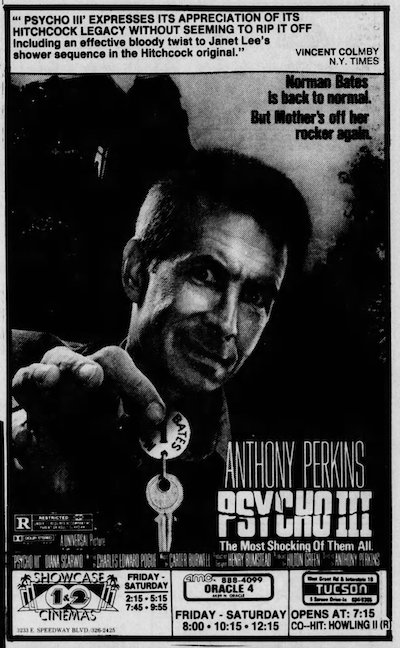 |
|
| Despite a big promotional push by Universal Studioes, PSYCHO III underperformd at the box office. |
Of making PSYCHO III, Perkins - who did an excellent job directing (especially considering he admits he learned to by reading a book) - further showed commercial sensibilities: “You know, ‘Psycho II’, for all its excellent qualities, is not an obsessive film. It has a laid-back quality. And it’s too long. Twenty minutes longer than this picture. Before I started filming, I timed the screenplay within a split second. I didn’t want to shoot too much, and have to cut it out, and leave loose ends, and have a 15-year-old skateboarder say I must have had a longer scene there once.”
However, despite its attempts at being a highly commercial sequel, PSYCHO III failed to engage with audiences in the same way Hitchcock’s first film - and to a lesser degree its first sequel (which had grossed a very respectable $34,725,000 in the US alone). Released on July 2, 1986, PSYCHO III grossed $14.4 million at the domestic box office on a budget of $8.4 million. Despite a big publicity push by Universal Studios - including full-page adverts in newspapers - it became the lowest-grossing film in the series.
Critics weren’t so kind, either. Chicago Tribune led with “3rd time around, ‘Psycho’ has lost all of its charm” Saying: “Part II was a conventional thriller, but Part III had Norman hacking away at times as if he were Jason from the ‘Friday the 13th’ series.”
However, Roger Ebert, in his syndicated column was actually positive about the movie. Talking of Perkins in his filmmaking debut he said: “I was surprised by what a good job he does. … Perkins isn’t an imitator. He has his own agenda.”
Bob Campbell in The Arizona Daily Star followed with: “Directing yourself in a movie must be like being Norman Bates. You’re following the commands of your own disembodied voice, and hoping that your other half knows what you’re doing.”
Michael Wilmington, in the LA Times, said: “Psycho III is better in more respects than II … It has some good writing and better than good acting, directing and writing. … But fails any sequel’s acid test. It feeds off the original without deepening it. … sequelitis takes over and the movie collapses into ‘Friday the 13th’.”
Of course, ‘collapsing into ‘Friday the 13th’’ isn’t such a bad thing - and we can only wonder what would have happened if Norman really had gone full Voorhees! Perhaps that could have been a different Part IV than the TV prequel/sequel we got in 1990 had PSYCHO III resonated with audiences in 1986.
BODYCOUNT 5  female: 4 / male: 1
female: 4 / male: 1
1) Female falls to her death
2) Female stabbed to death
3) Female has throat slit and stabbed
4) Male drowns
5) Female stabbed in back of head by statuette
Thank you for reading! And, if you've enjoyed this review, please consider a donation to help keep Hysteria Lives! alive! Donate now with Paypal.